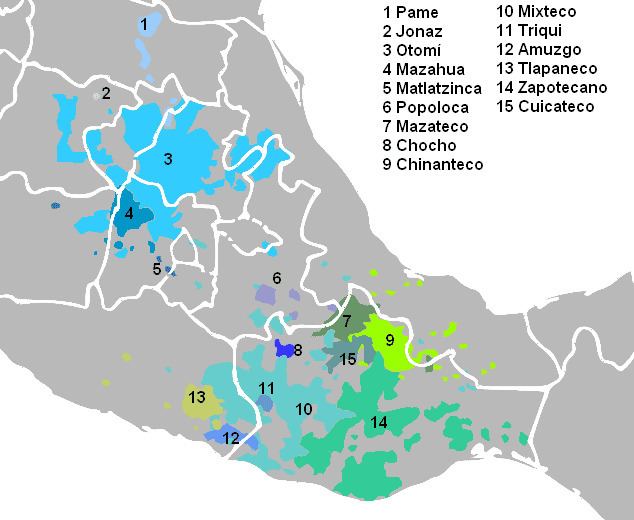Ethnicity Chinantecs | Native speakers 130,000 (2010 census) | |
 | ||
Language family Oto-MangueWestern Oto-MangueOto-Pame–ChinantecanChinantec ISO 639-3 Variously:cco – Comaltepec Chinantecchj – Ojitlán Chinantecchq – Quiotepec Chinantecchz – Ozumacín Chinanteccle – Lealao Chinanteccnl – Lalana Chinanteccnt – Tepetotutla Chinanteccpa – Palantla Chinanteccsa – Chiltepec Chinanteccso – Sochiapan Chinanteccte – Tepinapa Chinantecctl – Tlacoatzintepec Chinanteccuc – Usila Chinanteccvn – Valle Nacional Chinantec | ||
The Chinantec or Chinantecan languages constitute a branch of the Oto-Manguean family. Though traditionally considered a single language, Ethnologue lists 14 partially mutually unintelligible varieties of Chinantec. The languages are spoken by the indigenous Chinantec people who live in Oaxaca and Veracruz, Mexico, especially in the districts of Cuicatlán, Ixtlán de Juárez, Tuxtepec and Choapan, and in Staten Island, New York.
Contents
Languages
Egland and Bartholomew (1978) established fourteen Chinantec languages on the basis of 80% mutual intelligibility. Ethnologue found that one that had not been adequately compared (Tlaltepusco) was not distinct, but split another (Lalana from Tepinapa). At a looser criterion of 70% intelligibility, Lalana–Tepinapa, Quiotepec–Comaltepec, Palantla–Valle Nacional, and geographically distant Chiltepec–Tlacoatzintepec would be languages, reducing the count to ten. Leolao (Latani) is the most divergent.
Segmental phonology
A typical Chinantecan phoneme inventory distinguishes 7 vowels /i, e, a, u, o, ɨ, ø/ and consonants /p f b m θ d t ts s r l n k ŋ ʔ h/. Vowels can be nasalized, except usually /u/ and /ø/.
Tone
Chinantec is a tonal language and some dialects (Usila Chinantec) have five register tones, an uncommon trait in the world's languages. Whistled language is common. In the practical orthographies for Chinantec, tones are marked with superscript numbers after each syllable; in linguistic transcription the dedicated tone diacritics ⟨◌ꜗ ◌ꜘ ◌ꜙ ◌ꜚ⟩ are used.
Chinantec also has ballistic syllables, apparently a kind of phonation.
Grammar
Grammars are published for Sochiapam Chinantec, and a grammar and a dictionary of Palantla (Tlatepuzco) Chinantec.
Example phrase:
ca¹-dsén¹=jni chi³ chieh³‘I pulled out the hen (from the box).The parts of this sentence are: ca¹ a prefix which marks the past tense, dsén¹ which is the verb stem meaning "to pull out an animate object", the suffix -jni referring to the first person, the noun classifier chi³ and the noun chieh³ meaning chicken.
Media
Chinantec-language programming is carried by the CDI's radio stations XEOJN, broadcasting from San Lucas Ojitlán, Oaxaca, and XEGLO, broadcasting from Guelatao de Juárez, Oaxaca.
